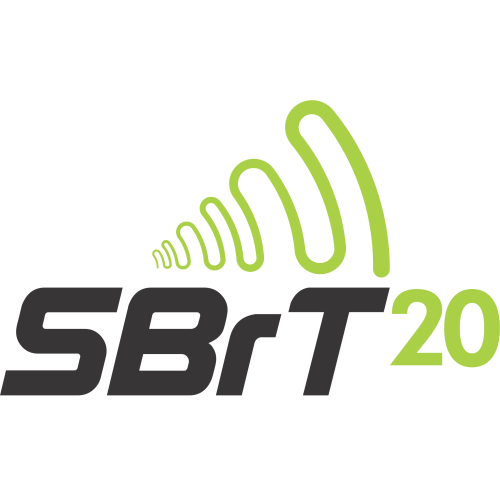
XXXVIII Simpósio Brasileiro de Telecomunicações e Processamento de Sinais
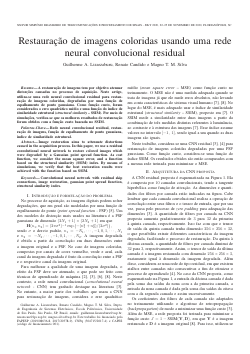
Restauração de imagens coloridas usando uma rede neural convolucional residual
Guilherme Lizarzaburu, Renato Candido, Magno T. M. Silva
DOI: 10.14209/SBRT.2020.1570649730
Keywords: Rede neural convolucional residual Restauração de imagens Função de espalhamento de ponto gaussiana Índice de similaridade estrutural
Abstract
Image restoration aims to attenuate distortions caused in the acquisition process. In this paper, we use a residual convolutional neural network to restore colored images which were degraded by a Gaussian point spread function. As cost function, we consider the mean square error, and a function based on the structural similarity (SSIM) index. By means of simulations, we verify that the best restoration results were achieved with the function based on SSIM.Download

Tempo de transição versus bounces em relés eletromecânicos e a geração de seeds randômicos
Carolina Zambelli, João Ranhel
DOI: 10.14209/SBRT.2020.1570649736
Keywords: random vectors electromechanical relays bounce LFSR on FPGA
Abstract
In this article we show that the time for changing states in electromechanical relays can generate random values. We use this phenomenon to generate seeds for linear feedback shift registers (LFSR). We created in FPGA a circuit derived from LFSR that generates 10^6 binary vectors per second with non-linear sequence. Statistical tests reveal confidence in the randomness of the generated values. We conclude that a low-cost relay and a digital circuit can become a good random vector generator. Surprisingly, the transition time in between relay states is more random than the number of bounces in the relay contacts.Download
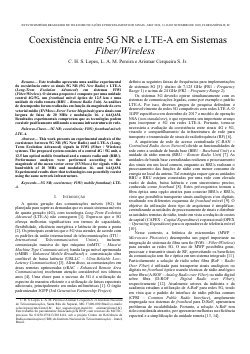
Coexistência entre 5G NR e LTE-A em Sistemas Fiber/Wireless
Celso Henrique, Arismar Cerqueira S. Jr., Luiz Augusto Melo Pereira
DOI: 10.14209/SBRT.2020.1570649771
Keywords:
Abstract
Este trabalho apresenta uma análise experimental da coexistência entre os sinais 5G NR (5G New Radio) e LTE-A (Long-Term Evolution Advanced) em sistemas FiWi (Fiber/Wireless). O sistema proposto é composto por uma unidade central 4G/5G, um fronthaul móvel óptico de 12,5 km e uma unidade de rádio remota (RRU - Remote Radio Unit). As análises de desempenho foram realizadas em função da magnitude do erro vetorial médio (EVMRMS -Error Vector Magnitude) para sinais com largura de faixa de 20 MHz e modulação 16- e 64-QAM. Resultados experimentais comprovam que as tecnologias podem coexistir pacificamente utilizando a mesma infraestrutura de rede.Download
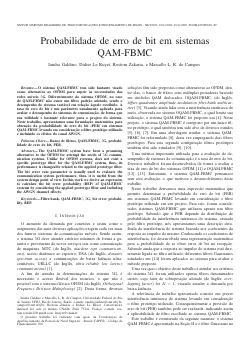
Probabilidade de erro de bit em sistemas QAM-FBMC
Iandra Galdino, Didier Le Ruyet, Rostom Zakaria, Marcello Campos
DOI: 10.14209/SBRT.2020.1570649777
Keywords: Banco de filtros QAM-FBMC probabilidade de erro de bit 5G
Abstract
The QAM-FBMC system have been a promising alternative to the OFDM for attempt the needs of 5G communication systems. Unlike for OFDM systems, does not exist a specific prototype filter for the QAM-FBMC system, thus, its performance is changeable related to the applied prototype filter. The bit error rate parameter is usually used to evaluate the communication system performance, thus, it is useful from the system design point of view. In this work we derive an expression to calculate the bit error probability (BEP) of QAM-FBMC systems by considering the applied prototype filter and including the AWGN channel effects.Download
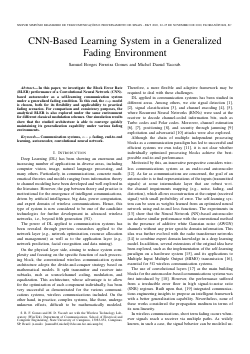
CNN-Based Learning System in a Generalized Fading Environment
Samuel Gomes, Michel Daoud Yacoub
DOI: 10.14209/SBRT.2020.1570649782
Keywords:
Abstract
In this paper, we investigate the Block Error Rate (BLER) performance of a Convolutional Neural Network (CNN)- based autoencoder as a self-learning communication system under a generalized fading condition. To this end, the α-µ model is chosen, both for its flexibility and applicability to practical fading scenarios. For comparison and consistency purposes, the analytical BLER is also explored under the same environment for different classical modulation schemes. Our simulation results show that the studied architecture is able to converge quickly maintaining its generalization capability under various fading environments.Download

RPCA para Detecção de Mudanças em Imagens SAR UWB VHF Explorando Diversidade
Lucas Pedroso Ramos, Christofer Schwartz, Dimas Irion Alves, Leonardo Tomazeli Duarte, Renato Machado
DOI: 10.14209/SBRT.2020.1570649883
Keywords: Synthetic Aperture Radar Change Detection RPCA Blind Source Separation
Abstract
This paper presents a method of change detection in ultrawideband (UWB) very high frequency (VHF) synthetic aperture radar (SAR) images, using the data analysis tool, robust principal component analysis (RPCA) via principal component pursuit (PCP). In this context, the proposed method considers stacks of SAR images to explore data diversity. For evaluation purposes, a set of SAR images from measurements of the CARABAS-II system was used. The experimental results demonstrate that the increase in diversity can improve the performance of the RPCA tool via PCP in change detection.Download
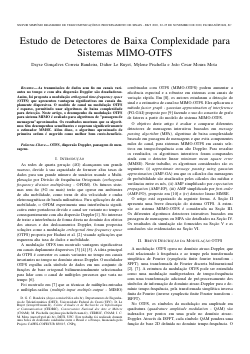
Estudo de Detectores de Baixa Complexidade para Sistemas MIMO-OTFS
Dayse Goncalves Correia Bandeira, Didier Le Ruyet, Mylene Pischella, Joao Cesar Moura Mota
DOI: 10.14209/SBRT.2020.1570649889
Keywords: OTFS dispersão Doppler passagem de mensagens
Abstract
As transmissões de dados sem fio em canais variantes no tempo e com alta dispersão Doppler são desafiadoras. Assim, foi proposta a modulação Orthogonal Time-Frequency Space (OTFS) que apresentou vantagens significativas em canais duplamente dispersivos. O modelo de canal na modulação OTFS é esparso, permitindo usar algoritmos de baixa complexidade para detecção. Neste artigo, o desempenho da modulação OTFS para sistema MIMO é avaliado para algoritmos de "passagem de mensagens" aproximados. Os resultados mostram que os algoritmos têm desempenhos semelhantes e superam significativamente o estimador MMSE. Além disso, o algoritmo aproximado de primeira ordem é sugerido como melhor bom custo-benefício.Download

Máscara Binária Variante no Tempo para Redução do Tempo de Detecção de TEOAEs
Augusto B. Pizzetta, Marcio H Costa, Maurício Tavares, Maria Madalena Pinheiro
DOI: 10.14209/SBRT.2020.1570649945
Keywords: TEOAE teste de audição triagem auditiva filtragem tempo-frequência
Abstract
Este trabalho apresenta a avaliação de desempenho de uma máscara binária variante no tempo, cuja finalidade é a redução do tempo de detecção de emissões otoacústicas evocadas por estímulo transiente (TEOAE). As variações das características espectrais intrínsecas da TEOAE foram utilizadas para configurar os parâmetros da máscara binária de forma a aumentar a razão sinal ruído do sinal processado. Experimentos com 8 voluntários normo-ouvintes, utilizando tanto um detector convencional em âmbito clínico quanto um detector de energia, indicaram uma redução média de 10% no tempo de detecção da TEOAE em relação ao sinal processado pelo método convencional. Devido ao baixo custo computacional, o método analisado é de especial interesse para sistemas embarcados de triagem auditiva.Download
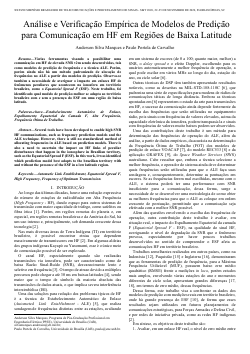
Análise e Verificação Empírica de Modelos de Predição para Comunicação em HF em Regiões de Baixa Latitude
Antonio Anderson Silva Marques, Paulo Henrique Portela de Carvalho
DOI: 10.14209/SBRT.2020.1570650078
Keywords: ALE ESF HF FOT
Abstract
Several prediction models and digital signal processing techniques have been developed for HF communication, especially the ALE technique, but there is still no standardized method for determining frequencies. In addition, there is a need to ascertain the impact on HF links of peculiar disturbances that happen in the ionosphere in Brazilian territory, such as the Equatorial Spread F (ESF). In this work, it was identified which prediction model best adapts to the Brazilian soil under certain conditions. The times of occurrence of the ESF and its impact on the degradation of the SNR of links in HF were also evaluated.Download
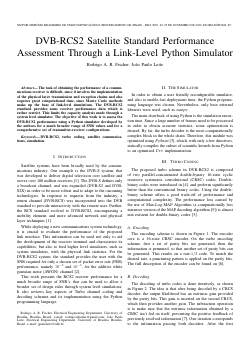
DVB-RCS2 Satellite Standard Performance Assessment Through a Link-Level Python Simulator
Rodrigo A. R. Fischer, João Paulo Leite
DOI: 10.14209/SBRT.2020.1570650142
Keywords: DVB-RCS2 turbo coding satellite communications simulation
Abstract
The task of obtaining the performance of a communications receiver is difficult, since it involves the implementation of the physical layer transmission and reception chains and also requires great computational time, since Monte Carlo methods make up the base of link-level simulations. The DVB-RCS2 standard provides some receiver performance data which is rather restrict. This limits the capacity analysis made through a system level simulator. The objective of this work is to assess the DVB-RCS2 performance using a Python simulator developed by the authors for a much broader range of SNR values and for a comprehensive set of transmitter-receiver configurations.Download